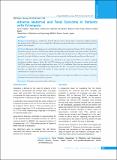Please use this identifier to cite or link to this item:
https://hdl.handle.net/20.500.14356/1484Full metadata record
| DC Field | Value | Language |
|---|---|---|
| dc.contributor.author | Pradhan, Tarun | - |
| dc.contributor.author | Rijal, Pappu | - |
| dc.contributor.author | Rai, Rubina | - |
| dc.contributor.author | Bhatta, Rabindra Dev | - |
| dc.contributor.author | Thapa, Baburam Dixit | - |
| dc.contributor.author | Regmi, Mohan Chandra | - |
| dc.date.accessioned | 2023-05-14T08:29:52Z | - |
| dc.date.available | 2023-05-14T08:29:52Z | - |
| dc.date.issued | 2018 | - |
| dc.identifier.citation | PradhanT., RijalP., RaiR., BhattaR. D., ThapaB. D., & RegmiM. C. (2019). Adverse Maternal and Fetal Outcome in Patients with Eclampsia. Journal of Nepal Health Research Council, 16(41), 425-427. https://doi.org/10.33314/jnhrc.v16i41.1159 | en_US |
| dc.identifier.issn | Print ISSN: 1727-5482; Online ISSN: 1999-6217 | - |
| dc.identifier.uri | http://103.69.126.140:8080/handle/20.500.14356/1484 | - |
| dc.description | Original Article | en_US |
| dc.description.abstract | Abstract Background: Eclampsia is a multisystem disorder that may lead to deterioration of maternal condition, hypoxia and acidosis of fetus. Objective was to evaluate the risk factors associated with adverse maternal and fetal outcome in patients with eclampsia. Methods: All patients with eclampsia were enrolled after informed consent from February 2013 to February 2014. Questions as per per-forma were asked to the patients and attendants about antenatal visits, parity, number of episodes of seizures, duration from onset of seizure to magnesium sulfate, then the patients were followed as per the hospital protocol, the mode of delivery, outcome of baby, post partum maternal condition and mortality were then noted. Results: Fifty-two patients with eclampsia were admitted in the study period. Thirty-one patients required mechanical ventilator support. Twenty-five (48.07%) patients were delivered by emergency cesarean section and 30(57.6%) babies were low birth weight and there were 11(21.1%) stillbirths. There was one maternal mortality and 45(86.5%) patients were discharged with improvement but 6(11.5%) patients had neurological impairment. Mortality was significantly related with number of seizure episodes and time interval between seizure onset and administration of magnesium sulphate. Conclusions: Early detection of hypertension and management with magnesium sulphate for eclampsia can help to minimize the maternal and fetal adverse outcomes. Keywords: Eclampsia; maternal mortality; risk factors. | en_US |
| dc.language.iso | en | en_US |
| dc.publisher | Nepal Health Research Council | en_US |
| dc.relation.ispartofseries | Oct-Dec 2018;1159 | - |
| dc.subject | Eclampsia | en_US |
| dc.subject | Maternal mortality | en_US |
| dc.subject | Risk factors | en_US |
| dc.title | Adverse Maternal and Fetal Outcome in Patients with Eclampsia | en_US |
| dc.type | Journal Article | en_US |
| local.journal.category | Original Article | - |
| Appears in Collections: | Vol. 16 No. 4 Issue 41 Oct - Dec 2018 | |
Files in This Item:
| File | Description | Size | Format | |
|---|---|---|---|---|
| 1159-Manuscript-7839-3-10-20190221.pdf | Fulltext Article. | 161.36 kB | Adobe PDF |  View/Open |
Items in DSpace are protected by copyright, with all rights reserved, unless otherwise indicated.
